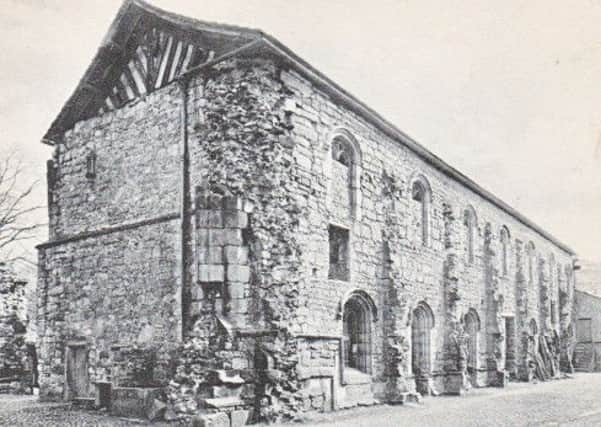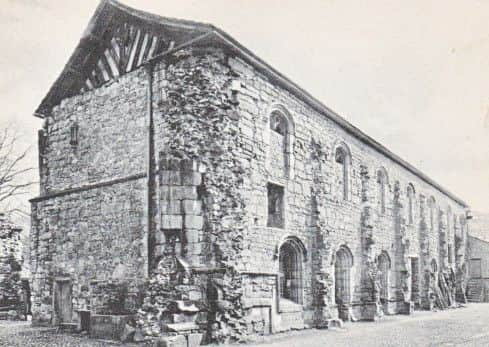Photos: So much history to discover in Whalley


However, we all know what the East Lancashire weather can do and it could be that when you are reading this the weather has returned to normal and there is a blizzard blowing outside your firmly shut front door!
We all live in hope so I will make the dangerous assumption the winds have relented and the heavens have opened, not to reveal rain, but early spring sunshine.
Advertisement
Hide AdAdvertisement
Hide AdAt this time of year my feet seem to be telling me it is time to get my boots on and revisit the places that mean something to me.


Today we are going to visit Whalley, a place of which I never tire.
When I go for a walk it is usually not to open countryside.
I like villages and, so far this year, have spent some time in a few of the Lake District villages of my ancestors. I have also visited Heysham and Arnside and the villages of Littondale, in North Yorkshire. A phone call, I received today from someone in Mawdesley, will take me to that village, possibly in the summer, to see, among other things, a bird sanctuary.
Advertisement
Hide AdAdvertisement
Hide AdVillages have long fascinated me. I have never been able to cope with big towns and cities.
Though I enjoyed the experience of living in London when I was a student, by the weekend I had to get on a Green Line bus. Several routes stopped conveniently outside my Muswell Hill flat, and I took advantage of this to make for the countryside, particularly of Bedfordshire, where my Frost ancestors came from, and Hampshire which, to me, because of its geology, is as varied as Lancashire.
Whalley is a little nearer home. It is, as you know, a fascinating village with a long history, but, in addition to that, it is set in magnificent countryside dominated by lovely woodland, much of which is accessible to the public. There are interesting walks all around the village, though my favourite takes me to the hills above Langho and Great Harwood.
I am also very fond of the flatter lands either side of the Calder as the river approaches its splendid confluence of the Ribble just below Great Mitton.
Advertisement
Hide AdAdvertisement
Hide AdThe village of Whalley is the home, to my mind, of one the most historic churches in England. The building itself, though not the most beautiful in the country, or even the county, it is claimed, was founded in the late 6th Century and there are parts of the present structure which can be dated to Norman times, though the greater part of the church is later.
More than that, the churchyard contains some superb ancient crosses which date from the latter part of what was, but erroneously, known as the Dark Ages, the time in English history between the fall of the Roman Empire and the coming of the Normans.
Of course the Dark Ages were not only experienced in England. It was a Europe-wide phenomena but the application of the term to England, especially in the later period, denigrates the great achievements of our Anglo-Saxon ancestors who were, in most things, more sophisticated than the Normans who eventually defeated them.
They say “history is written by the victors” and in Whalley you can see the village story told by the victors and the defeated.
Advertisement
Hide AdAdvertisement
Hide AdWhalley also contains the substantial remains of a Cistercian Abbey which, with the church, has significant connections with Burnley. In fact, for centuries Burnley looked to Whalley for leadership in religious matters and it is not generally realised that, out of the village’s dominant religious role, Burnley’s leading family, emerged.
It is probably not necessary for me to explain why Whalley once had a leading religious role in East Lancashire life.
In times when religion was more to the fore in the thoughts of our ancestors than it appears to be now, the ancient church, and powerful abbey, made Whalley an important place but how many of you realise the Towneley family came from Whalley?
At some time around 1200 Roger de Lacy, Lord of Clitheroe, granted to Geoffrey, his son-in-law, two oxgangs of land in Tunleia together with the right to pasture cattle on Burnley commons.
Advertisement
Hide AdAdvertisement
Hide AdOf course it was that grant that gave the Towneleys their surname. You cannot get much more local than that! But, at about the same time, Geoffrey obtained the right to hunt outside the Forest and, on such apparently small foundations, a dynasty was founded and, although the family have had their vicissitudes, the history of the Towneleys has been intertwined with that of Burnley ever since.
One of my reasons for visiting Whalley is that I can see the connections with my own home town, even the village, Harle Syke, where I live. It makes my walks in the village just that little more interesting. Whalley, however, had just about everything a visitor might want – some good buildings, yes, but a few interesting shops, some very good pubs, a number of good cafés and restaurants and some very friendly people.
Perhaps the only thing Whalley has not got is a museum or heritage centre. All villages of the historic importance of Whalley should have one or other. That it does not is, again to my mind, a failing of the village of Whalley and the borough of which it is part. Perhaps they have calculated they do not need a museum or heritage centre? It might be argued the Parish Church and Abbey more than suffice.
However, I would like to see a heritage centre, perhaps along the lines of Burnley’s Weavers’ Triangle Trust, in the village.
Advertisement
Hide AdAdvertisement
Hide AdIts role would be to tell the story of the village which has numerous claims to fame – a great battle which took place in the Dark Ages, a Civil War conflict, a significant role in the Pilgrimage of Grace, the most important of the uprisings against Henry VIII, and other locally interesting events, individuals and works of art that would complete the story.
How many of you realise, for instance, the founder of the discipline of Local History was a Vicar of Whalley?
Similarly, are you aware that just about the only English vestments used at a medieval monastic high altar were originally used in Whalley although they are now housed in Burnley?
Do you realise Whalley has a Roman history as well as a medieval history?
Advertisement
Hide AdAdvertisement
Hide AdAre you aware the ancient street pattern is still visible in the village where the sites of ancient buildings can still be determined?
How many of you know one of our greatest banks was founded in Whalley or the first Lancashire-Yorkshire cricket match took place in the village?
When you add all this up, Whalley is an interesting place.